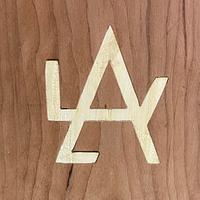Share your craft projects
Make new craft buddies
Ask craft questions
Blog your craft journey
First thing I would try is to use some DNA or Lacquer thinner to see if that removes the finish. This will strip shellac or most nitrocellulose lacquers. I dip a course stripping pad in DNA or LT and use that to apply and lightly abrade the finish to remove the old finish. Note that DNA will definitely strip shellac but it will sometimes slowly dissolve lacquer too. LT will remove both. If that doesn't work you may have to use a chemical stripper to get the old finish off. Either way, after strippring, you can then decide next steps and whether you want to use a stain to enhance the grain and get a more uniform appearance. If most of the color comes off with lacquer thinner, they may have originially finished it with a tinted lacquer.
Note that if the ring on the left does not come off while stripping the finish, it is may have been caused by someone putting a steel can on the top when it was wet. You may have to use some oxalic acid to get rid of the ring. If you are sure that it is not veneer on the top, you may be able to sand it out.
As for repairing the joints, can you see any old glue residue? When you wet it, if it turns sort of sticky, it is hide glue. If not, you may need to completely take it apart to clean old glue off. If it is hide glue you can probably just put some more hide glue in the joint and clamp it together. Personally I usually try to make repairs like that with hide glue if I can. It is not necessary to use hot hide glue. Old Brown Glue or Titebond Liquid hide glue will work just fine.
Note that if the ring on the left does not come off while stripping the finish, it is may have been caused by someone putting a steel can on the top when it was wet. You may have to use some oxalic acid to get rid of the ring. If you are sure that it is not veneer on the top, you may be able to sand it out.
As for repairing the joints, can you see any old glue residue? When you wet it, if it turns sort of sticky, it is hide glue. If not, you may need to completely take it apart to clean old glue off. If it is hide glue you can probably just put some more hide glue in the joint and clamp it together. Personally I usually try to make repairs like that with hide glue if I can. It is not necessary to use hot hide glue. Old Brown Glue or Titebond Liquid hide glue will work just fine.
--Nathan, TX. Hire the lazy man. He may not do as much work but that's because he will find a better way.









